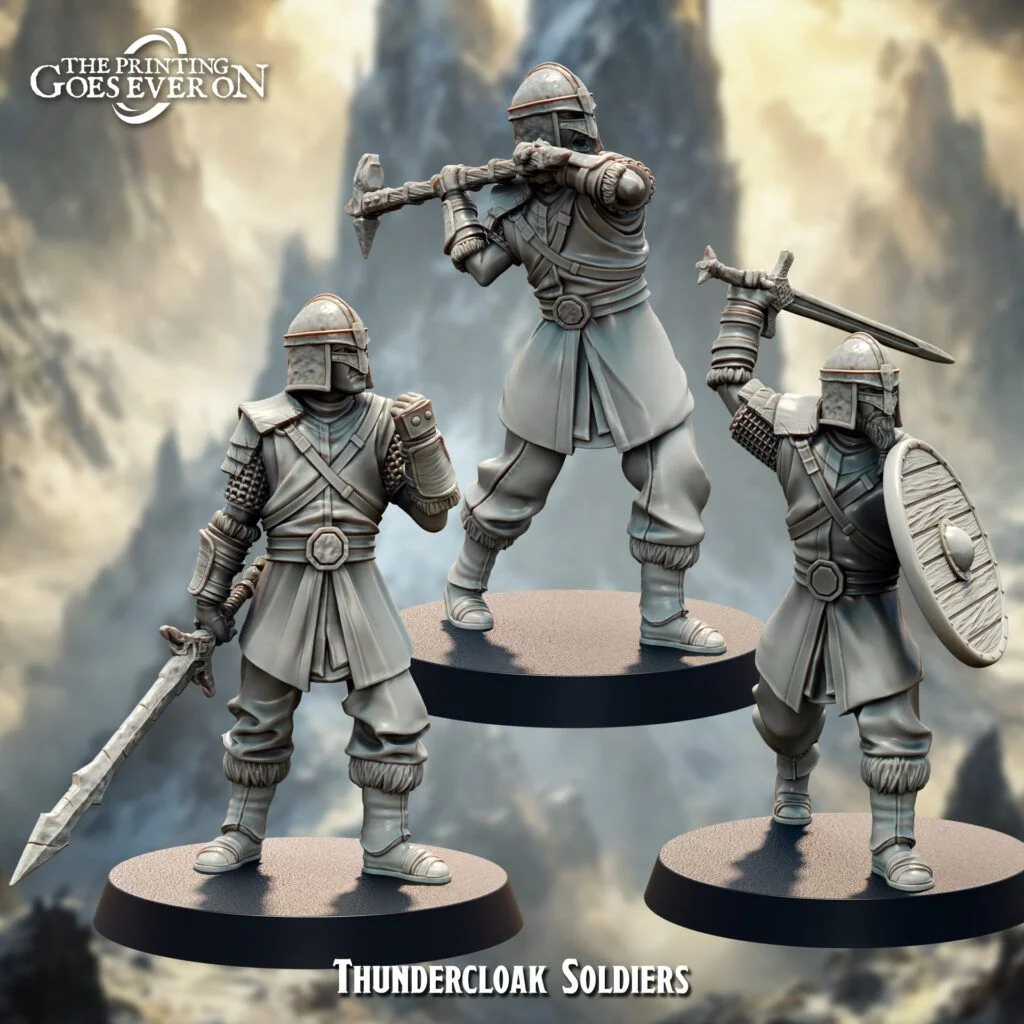
Best Filament Types for 3D Printing RPG Miniatures and Terrain
Choosing the right filament for 3D printing RPG miniatures and terrain is essential in bringing your tabletop games to life. Understanding which materials enhance detail, ensure durability, and offer ease of painting can make all the difference in your creations. Let’s dive into the best options available.
How to Choose the Best Filament for RPG Miniatures
Choosing the right filament for 3D printing RPG miniatures can make a big difference in how your models turn out. The filament you pick affects the level of detail, the strength and durability of the miniature, and how easy it is to finish and paint. When searching for the best filament for miniatures, it’s important to keep a few key factors in mind. Detail is key when making miniatures, since these small models need intricate designs and fine features. A filament that gives a smooth finish and high resolution works best. Durability is also important – strong materials that don’t chip or break easily help your miniatures survive hours of gameplay and handling.
Post-processing is another important factor when choosing filament for tabletop miniatures. Some materials are easier to sand, prime, and paint than others, which can make a big difference in how your finished model looks. A versatile filament that permits you to achieve the desired finish with minimal effort can enhance the overall appearance of your miniatures.This miniature printing filament guide shows that balancing detail, durability, and ease of post-processing is key to choosing the right filament. Considering these factors helps your RPG miniatures look great, last longer, and lets you level up your crafting skills for epic tabletop adventures.
Comparing PLA, PETG, and Resin for Fantasy Terrain
When 3D printing fantasy terrain for your tabletop RPGs, choosing between PLA, PETG, and resin can greatly affect the result, as each material has its own strengths and weaknesses. Starting with PLA, this filament type is a favorite among beginners due to its ease of use and affordability. PLA provides good print quality with a smooth finish, making it suitable for less intricate fantasy terrain. However, while it’s easy to print with, PLA lacks the durability and heat resistance needed for pieces that may be handled frequently during gameplay.
In the PLA vs PETG for miniatures debate, PETG offers a middle ground. It’s more durable and flexible than PLA, making it a great choice for terrain pieces that need strength without losing ease of use. Resin stands out for its exceptional surface detail and finish, ideal for high-detail terrain and intricate designs. However, resin can be more challenging to work with due to additional post-processing steps and safety precautions. When exploring filament types for DND printing, your choice will depend on what matters most – ease of use, durability, or fine detail – helping you find the perfect material for your fantasy creations.
Which Filament Works Best for High-Detail Dungeon Props?
Creating high-detail dungeon props for your RPG adventures requires a keen eye for detail and the right 3D printing filament to bring intricate designs to life. When precision and fine features are non-negotiable, selecting the appropriate high-detail filament for RPG models becomes crucial. For enthusiasts seeking to craft delicate props like ornate doors, detailed treasure chests, and intricate sculptural elements, the choice of filament can greatly affect the outcome. Resin stands out as a top contender in this realm due to its capability to capture the minutest details with exceptional clarity. Despite the additional steps required in post-processing, resin’s ability to deliver smooth finishes and sharp edges makes it a favorite among those aiming for professional-quality prints.
However, if you’re considering a more traditional filament-based approach, certain other materials also excel in creating detailed features. PLA, particularly when used with a fine nozzle, can produce impressive results for filament for RPG terrain, offering a balance of detail and ease of use. For projects that require a bit more durability without compromising on detail, consider PETG as a viable option. This filament type provides a stronger alternative to PLA while still maintaining a decent level of detail, making it suitable for 3D printing filament for dungeon props that might encounter more wear and tear. The choice of filament should align with the specific requirements of your project, whether that be unmatched detail with resin or a balance of durability and detail with advanced filaments like PETG.
A Guide to Filament Types for DND STL Printing
Different filament types for DND printing offer unique advantages and can transform your gaming experience with detailed and robust terrain and structures. PLA remains a popular choice for many due to its ease of use and reliable results. It’s ideal for crafting simple to moderately detailed terrains and is favored for its eco-friendly nature and variety of colors. However, PLA’s lack of heat resistance and lower durability might not be suited for more demanding play environments. If you’re aiming for enhanced durability, PETG might be your go-to. This filament offers superior strength and flexibility, making it apt for structures that might face frequent handling or slight impacts, retaining more intricate details compared to traditional PLA.
When exploring fantasy terrain filament types, ABS is a strong and heat-resistant option, ideal for permanent or load-bearing structures, though it needs a careful printing setup to avoid warping. For the finest details, resin stands out, delivering crisp, smooth finishes perfect for miniatures and models that need intricate designs. However, the post-processing demands, such as curing and safety precautions, are higher. Choosing filament types for STL terrain depends on what your project needs. PLA offers ease and accessibility, PETG brings extra durability, and resin provides unmatched detail. Each material has its own strengths, letting you tailor your DND terrain to match your creative vision.
Tips for Printing Durable and Detailed RPG Models
Creating RPG models that are both durable and detailed is an art that requires a combination of the right materials, precise printer settings, and meticulous finishing. Selecting the best filament for miniatures is the first step. For durability without compromising detail, PETG is a great choice due to its strength and flexibility, which can handle the rigors of gameplay. On the other hand, when high-resolution details are necessary, a resin-based approach could be more suitable, offering crisp and finely detailed surfaces. However, resin requires additional curing and handling precautions, which can be a challenge for beginners but worthwhile for achieving superior detail.
Optimizing your printer settings is just as important as choosing the right filament. Using lower layer heights can bring out more detail and give your models a smoother finish. Adjusting print speed and temperature also helps improve durability and overall quality. A common challenge is finding the right balance to avoid issues like warping or stringing, especially with detailed RPG miniatures. For the best results, spend time on post-processing steps like sanding, priming, and painting. These finishing touches not only make your miniatures look amazing, but also make them stronger and more durable for countless adventures at the gaming table.
Choosing Filament for Modular Terrain, Creatures, and More
When it comes to choosing filament for modular RPG components such as terrain pieces and creatures, flexibility and adaptability are key. The right filament can bring your role-playing adventures to life, offering detailed and durable components for your tabletop setups. For those wondering what filament is best for fantasy terrain, PLA remains a popular choice due to its accessibility and ease of use, allowing for the creation of intricate designs without the need for specialized equipment. PLA is especially suitable for modular pieces that need to fit together seamlessly, as it offers a good balance of detail and finish.
If your RPG setup demands more robust and impact-resistant parts, PETG might be the filament for RPG terrain you need. It combines the ease of PLA with additional strength, making it ideal for larger terrain pieces or creatures that might undergo frequent handling. For miniatures, choosing filament for tabletop miniatures that can capture the intricate details of fantastical creatures is crucial. Resin excels in this area, providing sharp details and smooth finishes, although it requires more cautious handling and post-processing. Ultimately, the choice of filament should align with your specific creative and practical needs, allowing for a versatile and engaging tabletop experience.


